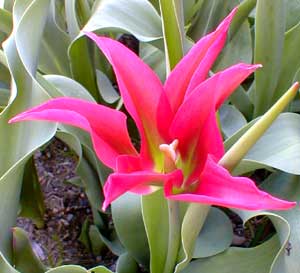
'Doll's Minuet' Tulip
"The ardency of fire, & on dull clay
Bestows the daring of the reckless moth.
Love, like the tulip, has one brand at heart."
-Muhammad Iqbal
(1876-1938)
(1876-1938)
'Doll's Minuet' tulip was introduced to gardening in 1963 by the Dutch hybriders Konijnenburg & Mark.
It bloom for us in April, & reaches twenty-two inches tall. They like a relatively dry location in full sun. The stems are relatively strong & upright & not as tippy as are some lily-flowering tulips. A rainy day can weight them over but they generally straighten back up when the sun returns.
We planted twenty bulbs at the garage corner, on the car's side of the wisteria, with 'Purple Prince' tulips on the alley side, & a few Muscari latifolium bicolor grape hyacinths poking up between.
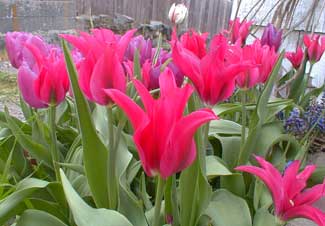 'Purple Prince' blooms for us mid-March to mid-April or a little longer, whereas 'Doll's Tulip' blooms early to mid-April & lasts into May. They overlap for a week or so, then when the 'Prince' is finished, 'Doll's Minuet' continues a week or two longer in that sunny spot.
'Purple Prince' blooms for us mid-March to mid-April or a little longer, whereas 'Doll's Tulip' blooms early to mid-April & lasts into May. They overlap for a week or so, then when the 'Prince' is finished, 'Doll's Minuet' continues a week or two longer in that sunny spot.'Doll's Minuet' is a 'Viridiflora' tulip, which is not a species, but a group of tulips that have varying amounts of green in the blossom. 'Doll's Minuet' is predominantly bright pink, but with green striping, less green than many other Viridifloras.
The green flames for 'Doll's Minuet' don't seem all that stable, but I've noticed with other lilyflowering tulips that their appearance isn't reliably the same year after year, but they change over time, 'Aladdin' having been another strong case in point.
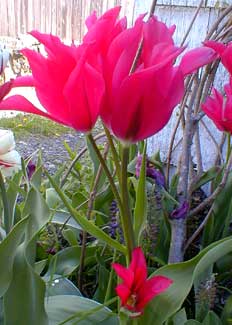 The first three photos on this page (from April 2004) show the mostly-pink apperance with only the lightest green streaks. The fourth & fifth photos are from 2005. The fourth picture shows 'Doll's Minuet' with more prounced streaking than for the first year, but the streaks are mostly white rather than green. The fifth photo is a close-up of a bloom on the opposite side of the drift; this one too has more prounced flames, but mostly yellow with just the bottom of the flames green.
The first three photos on this page (from April 2004) show the mostly-pink apperance with only the lightest green streaks. The fourth & fifth photos are from 2005. The fourth picture shows 'Doll's Minuet' with more prounced streaking than for the first year, but the streaks are mostly white rather than green. The fifth photo is a close-up of a bloom on the opposite side of the drift; this one too has more prounced flames, but mostly yellow with just the bottom of the flames green.Although streaked & lilyflowering tulips do seem to be prone to evolving different appearances year by year, in this case it is possible, maybe even likely, that a few of these bulbs got so much more streaky because the flames are not where the usual green streaking would've been; their increased ornateness may well be an enhancement caused by the tulip-breaking virus, as a few of the 'Purple Prince' in the same drift definitely have the virus (see the Broken Purple Prince page for the full story of tulip-breaking virus).
Some people destroy whatever broken tulips erupt in the garden because the virus can be spread by aphids & frequently shortens the number of years a tulip will bloom. Other folks preserve & even collect broken tulips because they truly are especially beautiful, & for hybrid tulips they would not have naturalized anyway, their lifespans being already limited.
The Viridiflora tulips do not form a large division, but a very interesting one. Tulips with green stripes are old to horticulture, the earliest being pictured in an illustration for Besler's Hortus Eystettensis (1613), & the first named cultivar being 'Groene Ridder' ('Green Knight') from 1700.
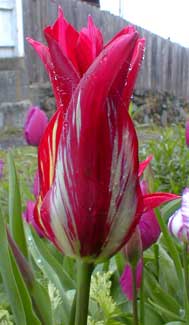 Modern Viridiflora tulips, however, are not so old as that. These short-stemmed Viridifloras are in the main related to a cultivar called 'Artist,' while the long-stemmed varieties are of less specific origin. 'Artist' was introduced in 1947 by the Captein Brothers, who arrived at this bloom by crossing the Single Early hybrid 'General de Wet' with a Triumph called 'Palestrina.' The resulting flower was salmon-pink with green flames. Through sports, 'Artist' all but singlehandedly gave rise to what was eventually to become a new division of tulips.
Modern Viridiflora tulips, however, are not so old as that. These short-stemmed Viridifloras are in the main related to a cultivar called 'Artist,' while the long-stemmed varieties are of less specific origin. 'Artist' was introduced in 1947 by the Captein Brothers, who arrived at this bloom by crossing the Single Early hybrid 'General de Wet' with a Triumph called 'Palestrina.' The resulting flower was salmon-pink with green flames. Through sports, 'Artist' all but singlehandedly gave rise to what was eventually to become a new division of tulips.Adriaan & Jan Captein were cattle farmers who fell in love with tulip breeding. For a couple of decades after they came up with 'Artist,' a fad arose for this unexpected new type, which encouraged further cultivars to be developed. It was not until 1987 that there were enough "green-flower" varieties to justify being placed into their own division.
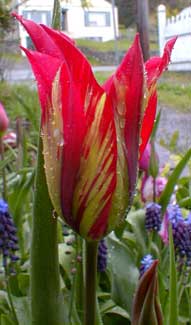 Hybrid tulips frequently fit into more than one tulip category. This particular Viridiflora greatly resembles the Lily-flowering tulips with its pointy recurved petals. What is more, it is one of the very few multi-flowering tulips.
Hybrid tulips frequently fit into more than one tulip category. This particular Viridiflora greatly resembles the Lily-flowering tulips with its pointy recurved petals. What is more, it is one of the very few multi-flowering tulips.The stem from each bulb frequently forks, so that the stem often has two complete flowers instead of one. It does not multi-flower often, however, unlike, say, 'Georgette,' with several flowers per stem, wearing itself out so that it fades away year by year. 'Doll's Minuet' does not wear itself out & can continue to produce flowers for many years.
The third photo shows an extreme example of 'Doll's Minuet' multiflowering potential, in that this particular bulb produced three large flowers on a trident-forked stem, plus about halfway down the stem there was a "spur" or fourth prong to the fork, with a half-sized flower.
When we obtained this bulb nothing described it as multi-flowering, so it was quite amazing that several of the bulbs produced at least twinned flowers, with the a couple triplets & this one quadruplet. Not quite all the bulbs flowered their second year, & it appears that it was only the bulbs which multiflowered which weakened & faded.
Even before it is in full bloom 'Doll's Minuet' is a novel & attractive plant. Its large buds are forming in late March & early April, big round onion-dome buds that are green with white streaks, being an exact color-match for the broad very beautiful folliage which starts out white-rimmed. Not until about the end of the first week in April does the pink begin to show at the cracks of the bud.